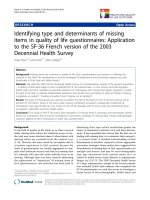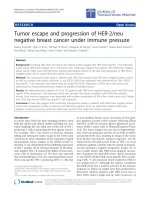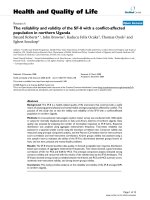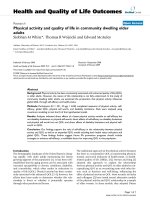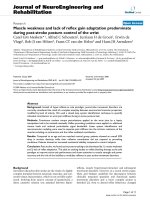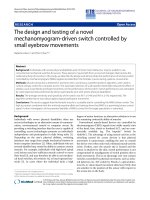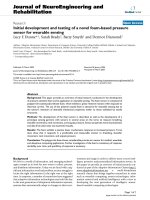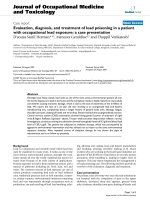báo cáo hóa học:" Tumor escape and progression of HER-2/neu negative breast cancer under immune pressure" pdf
Bạn đang xem bản rút gọn của tài liệu. Xem và tải ngay bản đầy đủ của tài liệu tại đây (485.15 KB, 5 trang )
RESEARC H Open Access
Tumor escape and progression of HER-2/neu
negative breast cancer under immune pressure
Maciej Kmieciak
1
, Kyle K Payne
1
, Michael O Idowu
2
, Margaret M Grimes
2
, Laura Graham
3
, Maria-Libera Ascierto
4
,
Ena Wang
4
, Xiang-Yang Wang
5
, Harry D Bear
3
and Masoud H Manjili
1*
Abstract
Background: Emerging data from pre-clinical and clinic al studies suggest that HER-2/neu-specific T cell responses
could induce HER-2/neu antigen loss in the tumor cells. These data sugg est that patients with HER-2/neu negative
breast cancer might have had HER-2/neu positive premalignant lesions in the past that progressed to HER-2/neu
negative breast cancer under HER-2/neu-specific immune pressure.
Methods: We conducted a pilot study in patients with HER-2/neu positive and HER-2/neu negative breast cancers
as well as a patient with ductal carcinoma in situ (DCIS). HER-2/neu expression was determined by FISH. HER-2/
neu-specific T cell responses were determined by using IFN-g ELISA. Expression of IFN-g Ra in the tumors was
determined by immunohistochemistry analysis of paraffin-embedded tissues.
Results: We determined that majority of (10 of 12) patients with HER-2/neu negative breast cancer had HER-2/neu-
specific IFN-g producing T cell responses which was stronger than those in patients with HER-2/neu positive
tumors. Such immune response s were associated with nuclear translocation of IFN-g Ra in their tumor cells. Patient
with DCIS also showed HER- 2/neu-specific T cell responses.
Conclusion: These data suggest that conducting retrospective studies in patients with HER-2/neu negative breast
cancers and prospective studies in patients with HER-2/neu positive DCIS can determine whether HER-2/neu
negative invasive carcinomas arise from HER-2/neu positive DCIS under the immune pressure.
Introduction
In recent years, there has been emerging evidence from
both pre-clinical and clinical studies, including our own,
which challenge the one-sided view of the role of IFN-g
producing T cells in protecting the host against cancers.
For example, IFN-g was shown to promote immune
editing and subsequent tumor escape in the CT26 colon
carcinoma by down-regulation of the expression of gp70
immunogenic tumor antigen at the mRNA levels [1].
Recently, it was d emonstrated that inhibiting expression
of IFN-g receptor (R) by forcing expression of the domi-
nant negative IFN-g R redu ced the ability of renal carci-
noma cells to metastasize [2]. We have also reported
that immunotherapy of rat neu expressing breast cancer
elicits neu-specific IFN-g producing CD8+ T cells that
in turn facilitate breast cancer recurrence of neu
Anti-
gen
Negative Variant (ANV) tumors following initial
rejection of the neu positive
Mouse Mammary Carci-
noma (MMC) tumor cells in immunocompetent mice
[3,4]. The tumor antigen loss was due to hypermethyla-
tion of the neu promoter and loss of neu both at mRNA
and protein levels [3,5], resulting in escape of the tumor
from further neu-specific immune responses. On the
clinical front, elevated serum levels of IFN-g in uveal
melanoma patients correlate with the spread of metasta-
sis and represent a negative prognostic marker [6]. It
was recently shown that HER-2/neu-targeted vaccina-
tion of patients who had HER -2/neu+ duct al carcinoma
in situ (DCIS) elicited HER-2/neu-specific IFN-g produ-
cing CD8+ T cell responses which resulted in HER-2/
neu antigen loss [7]. Although the authors considered
this HER-2/neu loss a positive outcome of the immune
response, no follow-up studies have been performed to
determine whether patients with HER-2/neu loss in
their DCIS tumors might end up with recurrence of
* Correspondence:
1
Department of Microbiology & Immunology, Virginia Commonwealth
University Massey Cancer Center, 401 College Street, Richmond VA 23298,
USA
Full list of author information is available at the end of the article
Kmieciak et al. Journal of Translational Medicine 2011, 9:35
/>© 2011 Kmieciak et al; lice nsee BioMed Central Ltd. This is an Open Ac cess article distributed u nder the terms of the Creative
Commons Attribution License ( 2.0), which permits unrest ricted use, distribution, and
reproduction in any medium , provided the original work is properly cited.
invasive HER-2/neu positive or negative breast cancers.
Several other co rrelative or in vitro studies suggest
potentially negative effects of some immune responses
in breast cancer. Matkowski and Sheu both showed in
cohorts of 88 and 24 patients with operable breast can-
cer, respectively, that relapse or disease progression was
associated with strong CD8+ T cell infiltra tion [8,9].
Interestingly, it was reported that HER-2/neu+ human
prostate tumor cell lines, DU145 and PC-3, that
responded to IFN-g (because of the expression of IFN-g
Ra), showed down-regulation of HER-2/neu expression
whereas another prostate tumor cell line, LNCaP, that
failed to respond to IFN-g didnotshowanychangein
the expression of HER-2/neu [10]. Such failure of the
LNCaP to respond to IFN-g was later shown to be due
to the lack of JAK1 expression [11]. The se findings
prompted us to determine whether HER-2/neu-specific
IFN-g producing T cell responses may be associated
with HER-2/neu loss and progression to HER-2/neu
negative breast carcinoma. To test this hypothesis, we
conducted pilot studies in patients with HER-2/neu
positive and HER-2/neu negative breast carcinoma to
determine whether patients with HER-2/neu negative
tumors had HER-2/neu-specific T cell responses that
had been induced by HER-2/neu positive pre-malignant
lesions in the past.
Materials and methods
Patient specimens
Formalin-fixed paraffin-embedded tumor blocks were
prepared from 15 patients with breast cancer among
which 12 patients had HER-2/neu negative tumors and
three patients had HER-2/ne u positive tumors, as deter-
mined by fluorescence in situ hybridization (FISH). We
also included two samples from a patient with ductal
carcinoma in situ (DCIS). Peripheral blood mononuclear
cells (PBMCs) and sera were also obtained from these
patients and used for in vitro studies. This study was
conducted under Institutional Review Board (IRB) pro-
tocol# HM10920 at Virginia Commonwealth University.
All patients had the capacity to g ive informed consent
to participate in this research.
IFN-g ELISA
PBMCs were harvested from the blood of invasive breast
cancer patients (n = 15) and two samples from a patient
with DCIS. After Ficoll density gradient separation,
PBMCs were cultured at 37°C for 2 hr, adherent cells
were used for the generation of monocyte-derived DCs
in the presence of GM-CSF (100 ng/ml) and IL-4 (50
ng/ml), as previous ly describ ed by our group [12]. Floa-
ter cells were maintained with IL-2 (40 U/ml/10
6
cells)
in complete medium for 6-7 days until autologous DCs
became available. The IL-2 maintained lymphocytes
were then cultured with autologous DCs (4:1) in
the presence or absence of recombinant HER-2/neu
(100 μg/ml) or LPS (10 μg/ml). After 24 hs, superna-
tants were collected and subjected to IFN-g ELISA. We
used a Human IFN-g ELISA set according to the manu-
facture’s protocol (BD Pharmingen).
Recombinant HER-2/neu protein
The SK-BR-3 breast tumor line that overexpresses
HER-2/neu was used to prepare the cDNA. Extracellu-
lar domain (ECD) and intracellular domain (ICD) of
HER-2/neu were amplified using specific primers.
ECD-forward: 5’ AAA CTC GAG ATG GAG CTG
GCG GCC TTG T 3’ and reverse: 5’ CTT AAG CTT
CGT CAG AGG GCT GGC TCT CT 3’ ;ICD-forward:
5’ AAACTCGAGAAGCGACGGCAGCAGAAG
AT 3’ and reverse: 5’ CTT AAG CTT TCA CAC TGG
CAC GTC CAG 3’ . The orientation and integrity of
inserted sequence were screened by detailed restriction
analysis and sequencing. DNA encoding the ECD (aa
1-695) or ICD (aa 692-1256) were ligated into the
expression vector pRSET (Invitrogen). The BL21 (DE3)
pLysS strain of E. coli was used for the expression the
proteins. Proteins were purified under denaturing con-
dition using Invitrogen ProBond Purification System.
The ECD and ICD proteins were then dialyzed using
10 mM Tris, p H 8.0, and 20 mM Tris pH 9.0, respec-
tively. Purity of the proteins was above 90% as deter-
mined by SDS-PAGE.
Immunohistochemistry (IHC)
In order to determine the status of IFN-g Ra expression
in the tumors IHC was performed using Dako auto-
mated immunostainer (Dako, Carpinteria, CA). We used
ant i-hu man IFN-g Ra antibody (Santa Cruz Biotechnol-
ogyInc.,SantaCruz,CA).Theantigenretrievalwas
achieved using a rice steamer. In order to circumvent
the endogenous b iotin activity, we used Dako Envision
Dual Link System-HRP (Dako, Capinteria CA) in a two-
step IHC technique, based on HRP labeled polymer
which is conjugated with secondary antibodies. The
labeled polymer does not contain avidin or biotin,
thereby avoiding the non specific endogenous avidin-
biotin activity in the sections. Positive and negative con-
trols stained appropriately.
Statistical analysis
Statistical comparisons between groups were made using
an unpaired Student’s t test with P < 0.05 being statisti-
cally significant.
Kmieciak et al. Journal of Translational Medicine 2011, 9:35
/>Page 2 of 5
Results
Detection of HER-2/neu-specific IFN-g positive T cell
responses in HER-2/neu negative breast cancer patients
Of 12 patients with HER-2/neu negative breast cancers
(stages I-IIIA) ten patients showed HER-2/neu-specific
IFN-g producing T cell responses (Figure 1A). All
three patients with HER-2/neu positive breast cancer
also showed HER-2/neu-specific T cell responses. As
shown in Figure 1A, patients with HER-2/neu positive
tumors showed significantly lower IFN-g resp onses to
HER-2/neu compared to HER-2/neu negative patients
(HER-2/neu positive: 22-120 ng/ml, HER-2/neu nega-
tive: 61-600 ng/ml, P = 0.012). These responses were
detected in the PBMC of patients prior to any treat-
ment. Samples from a DCIS patient also showed HER-
2/neu-specific T cell responses (Figure 1B). No
ECD-specific IgG antibody response was detected in
theseraofthesepatients(datanotshown).Patient
characteristics are shown in Table 1.
Nuclear translocation of IFN-g Ra in the tumors of
patients with HER-2/neu-specific T cell responses
Since nuclear translocation of IFN-g Ra is a conse-
quence of IFN-g signaling in the tumor cells, we per-
formed IHC analysis of the tumor lesions of the patients
using anti-human IFN-g Ra antibody. As can be seen in
Figure 1C, patients with HER-2/neu negative tumors
and who had strong HER-2/neu-specific T cell
responses showed an intense and uniform nuclear stain-
ing for IFN-g Ra in their tumors while those with no T
cell responses showed weak cytosolic staining for IFN-g
Ra in their tumors. Patients with low levels of HER-2/
neu-specific IFN-g production (HER-2/neu positive or
HER-2/neu negative tumors) showed weak and scattered
Figure 1 HER-2/neu-specific T cell responses in patients with HER-2/n eu negative or positive bre ast cancers. Peripheral blood T cells
were isolated from patients with HER-2/neu positive (patients #7, 13, 14) or HER-2/neu negative (all other patients) breast cancers (stage I-III) (A)
and two samples from DCIS patient (B). T cells were then co-cultured with or without DCs in a 2:1 ratios in the presence or absence of
recombinant human HER-2/neu (intracellular domain + extracellular domain: ECD+ICD, 100 μg/ml) for 24 hrs. Supernatants were collected and
subjected to IFN-g ELISA. C) Representative IHC staining (200× magnification) of tumor lesions of patients with HER-2/neu negative (-) and HER-
2/neu positive (+) tumors who had HER-2/neu-specific T cell responses or no T cell responses.
Kmieciak et al. Journal of Translational Medicine 2011, 9:35
/>Page 3 of 5
nuclear staining along with cytosolic staining for IFN-g
Ra in their tumors.
Discussion
If HER-2/neu-specific IFN-g producing T cells are
involved in HER-2/neu loss and tumor recurrence, we
might be able to detect such immune responses in
patients with HER-2/neu negative breast cancer, who
might have had undetectable HER-2/neu positive pre-
malignant tumors in the past, that had lost HER-2/neu
expression and progresse d to invasive carcinoma under
the immune pressure. The fact that 55-75% of patients
with premalignant DCIS overexpress HER-2/neu in their
tumor lesions and 75% of breast cancers are HER-2/neu
negative would suggest the progression of HER-2/neu
positive DCIS to HER-2/neu negative breast cancer is
only in the tumor clones that express IFN-g Ra.We
have already shown that T cell-mediated tumor antigen
loss was due to hypermethylation of the neu promoter
and loss of neu both at mRNA and protein levels [3,5].
It is likely that DNA me thylation may also impact HER-
2/neu gene amplification, as suggested by others [13].
We performed a pilot study accruing 12 breast cancer
patients with HER-2/neu negative tumors (HER-2/neu
status: FISH negative) and t hree breast cancer patients
with HER-2/neu positive tumors (FISH positive). We
detected HER-2/neu-specific IFN-g producing T cell
responses in PBMC of patients with HER-2/neu negative
cancers (10 out of 12 patients). Interestingly, there was a
direct correlation between the HER-2/neu-specific T cell
responses and nuclear l ocalization of IFN-g Ra in the
tumors, as an indication of IFN-g responses at the
tumor site [14]. A higher IFN-g production in a majority
of patients with HER-2/neu negative tumors compared
to those with HER-2/neu positive tumo rs suggests the
presence of high affinity T cells in the former. Weak T
cell responses were associat ed with weak and scattered
nuclear and cytosolic IFN-g Ra while stronger T cell
responses in patients with HER-2/neu- tumors was asso-
ciated with an intense and uniform nuclear IFN-g Ra.
Our findings suggest that the increased rate of HER- 2/
neu positive DCIS compared with breast cancer may
reflect the loss of HER-2/neu during tumorigenesis in
premalignant cells where IFN-g signaling pathway is
active. This possibility is also supported by a number of
observations reported by other groups. For instance,
induction of HER-2/neu-specific IFN-g producing T cell
responsesinpatientswithDCISresultedinlossof
HER-2/neu expression [7]. It was also reported that
overexpression of HER-2/neu in DCIS lesions predicts
the presence of invasive foci in pati ents with DCIS [15].
Others also have suggested that the low frequency of
HER-2/neu expression (20-25%) in invasive breast can-
cer implies that HER-2/neu loss is an epiphenomenon
of disease progression [16].
Conclusions
The results of this study emphasize a potentially critical
role for an inflammatory type of anti-tumor immune
responses [17,18] such as IFN-g which can facilitate
tumor antigen loss and relapse of more invasive tumors.
Presence of HER-2/neu-specific T cell responses in
DCIS patients who have IFN-g Ra positive lesions may
suggest that these patients are at risk of developing
HER-2/neu negative breast cancer. This needs to be
determined by conducting prospective studies in
patients with DCIS.
Acknowledgements
This work was supported by Massey Cancer Center Pilot Project Program
2006FPP-04 (M. H. Manjili) and VCU Presidential Research Incentive Program
145820 (M. H. Manjili). We also thank Dr. Elizabeth Bolesta for helping with
the expression of the recombinant proteins.
Author details
1
Department of Microbiology & Immunology, Virginia Commonwealth
University Massey Cancer Center, 401 College Street, Richmond VA 23298,
USA.
2
Department of Pathology, Virginia Commonwealth University Massey
Cancer Center, 1200 E. Marshall Street, Richmond VA 980662, USA.
3
Department of Surgery, Virginia Commonwealth University Massey Cancer
Center, 1200 E. Broad Street, Richmond VA 980011, USA.
4
Infectious Disease
and Immunogenetics Section (IDIS), Department of Transfusion Medicine,
Clinical Center and Center for Human Immunology (CHI), National Institutes
of Health, 10 Center Drive, Bethesda, MD 20892, USA.
5
Department of
Human and Molecular Genetics, Virginia Commonwealth University Massey
Cancer Center, 401 College Street, Richmond VA 23298, USA.
Authors’ contributions
MK prepared blood samples, monocyte- dereived dendritic cells, and
performed IFN-γ ELISA, KKP participated in drafting the manuscript and data
analysis, MOI and MMG performed IHC analysis, LG prepared blood samples,
M-LA, EW and X-YW participated in drafting the manuscript and data
Table 1 Patients’ characteristics
Patients Stage of tumor HER-2 status
#2 I -
#3 I -
#4 IIA -
#5 IIB -
#6 I -
#8 IIIA -
#9 IIA -
#10 IIA -
#11 IIA -
#12 I -
#14 I -
#16 I -
#7 IIA +
#13 I +
#15 II +
Kmieciak et al. Journal of Translational Medicine 2011, 9:35
/>Page 4 of 5
analysis, HDB coordinated clinical aspects of the study including patient’s
accrual and participated in drafting the manuscript, MHM conceived the
study, designed the experiments, analyzed data and wrote the manuscript.
All authors read and approved the final manuscript.
Competing interests
The authors declare that they have no competing interests.
Received: 2 March 2011 Accepted: 31 March 2011
Published: 31 March 2011
References
1. Beatty GL, Paterson Y: IFN-gamma can promote tumor evasion of the
immune system in vivo by down-regulating cellular levels of an
endogenous tumor antigen. J Immunol 2000, 165:5502-5508.
2. Hall VL, Subleski J, Back TC, Gruys ME, Shorts-Cary L, Weiss JM, Wiltrout RH:
Friend or Foe? IFN Mediates Pro-Metastatic Gene Expression in the
Tumor Microenvironment. J Immunol 2007, 178:48.34.
3. Kmieciak M, Knutson KL, Dumur CI, Manjili MH: HER-2/neu antigen loss
and relapse of mammary carcinoma are actively induced by T cell-
mediated anti-tumor immune responses. Eur J Immunol 2007, 37:675-685.
4. Worschech A, Kmieciak M, Knutson KL, Bear HD, Szalay AA, Wang E,
Marincola FM, Manjili MH: Signatures associated with rejection or
recurrence in HER-2/neu positive mammary tumors. Cancer Res 2008,
68:2436-2446.
5. Santisteban M, Reiman JM, Asiedu MK, Behrens MD, Nassar A, Kalli KR,
Haluska P, Ingle JN, Hartmann LC, Manjili MH, Radisky DC, Ferrone S,
Knutson KL: Immune-induced epithelial to mesenchymal transition in
vivo generates breast cancer stem cells. Cancer Res 2009, 69:2887-2895.
6. Hallermalm K, Seki K, De Geer A, Motyka B, Bleackley RC, Jager MJ,
Froelich CJ, Kiessling R, Levitsky V, Levitskaya J: Modulation of the tumor
cell phenotype by IFN-gamma results in resistance of uveal melanoma
cells to granule-mediated lysis by cytotoxic lymphocytes. J Immunol
2008, 180:3766-3774.
7. Czerniecki BJ, Koski GK, Koldovsky U, Xu S, Cohen PA, Mick R, Nisenbaum H,
Pasha T, Xu M, Fox KR, Weinstein S, Orel SG, Vonderheide R, Coukos G,
DeMichele A, Araujo L, Spitz FR, Rosen M, Levine BL, June C, Zhang PJ:
Targeting HER-2/neu in early breast cancer development using dendritic
cells with staged interleukin-12 burst secretion. Cancer Res 2007,
67:1842-1852.
8. Matkowski R, Gisterek I, Halon A, Lacko A, Szewczyk K, Staszek U,
Pudelko M, Szynglarewicz B, Szelachowska J, Zolnierek A, Kornafel J: The
prognostic role of tumor-infiltrating CD4 and CD8 T lymphocytes in
breast cancer. Anticancer Res 2009, 29:2445-2451.
9. Sheu BC, Kuo WH, Chen RJ, Huang SC, Chang KJ, Chow SN: Clinical
significance of tumor-infiltrating lymphocytes in neoplastic progression
and lymph node metastasis of human breast cancer. Breast 2008,
17:604-610.
10. Kominsky SL, Hobeika AC, Lake FA, Torres BA, Johnson HM: Down-
regulation of neu/HER-2 by interferon-gamma in prostate cancer cells.
Cancer Res 2000, 60:3904-3908.
11. Dunn GP, Sheehan KC, Old LJ, Schreiber RD: IFN unresponsiveness in
LNCaP cells due to the lack of JAK1 gene expression. Cancer Res 2005,
65:3447-3453.
12. Kmieciak M, Gowda M, Graham L, Godder K, Bear HD, Marincola FM,
Manjili MH: Human T cells express CD25 and Foxp3 upon activation and
exhibit effector/memory phenotypes without any regulatory/suppressor
function. J Transl Med 2009, 7:89.
13. Terada K, Okochi-Takada E, Akashi-Tanaka S, Miyamoto K, Taniyama K,
Tsuda H, Asada K, Kaminishi M, Ushijima T: Association between frequent
CpG island methylation and HER2 amplification in human breast
cancers. Carcinogenesis 2009, 30:466-471.
14. Larkin J, Johnson HM, Subramaniam PS: Differential nuclear localization of
the IFNGR-1 and IFNGR-2 subunits of the IFN-gamma receptor complex
following activation by IFN-gamma. J Interferon Cytokine Res 2000,
20
:565-576.
15. Roses RE, Paulson EC, Sharma A, Schueller JE, Nisenbaum H, Weinstein S,
Fox KR, Zhang PJ, Czerniecki BJ: HER-2/neu overexpression as a predictor
for the transition from in situ to invasive breast cancer. Cancer Epidemiol
Biomarkers Prev 2009, 18:1386-1389.
16. Hoque A, Sneige N, Sahin AA, Menter DG, Bacus JW, Hortobagyi GN,
Lippman SM: Her-2/neu gene amplification in ductal carcinoma in situ of
the breast. Cancer Epidemiol Biomarkers Prev 2002, 11:587-590.
17. Amsen D, de Visser KE, Town T: Approaches to determine expression of
inflammatory cytokines. Methods Mol Biol 2009, 511:107-142.
18. de Visser KE: Spontaneous immune responses to sporadic tumors: tumor-
promoting, tumor-protective or both? Cancer Immunol Immunother 2008,
57:1531-1539.
doi:10.1186/1479-5876-9-35
Cite this article as: Kmieciak et al.: Tumor escape and progression of
HER-2/neu negative breast cancer under immune pressure. Journal of
Translational Medicine 2011 9:35.
Submit your next manuscript to BioMed Central
and take full advantage of:
• Convenient online submission
• Thorough peer review
• No space constraints or color figure charges
• Immediate publication on acceptance
• Inclusion in PubMed, CAS, Scopus and Google Scholar
• Research which is freely available for redistribution
Submit your manuscript at
www.biomedcentral.com/submit
Kmieciak et al. Journal of Translational Medicine 2011, 9:35
/>Page 5 of 5


